The Cultural and Architectural Essence of Dubai's White Palace
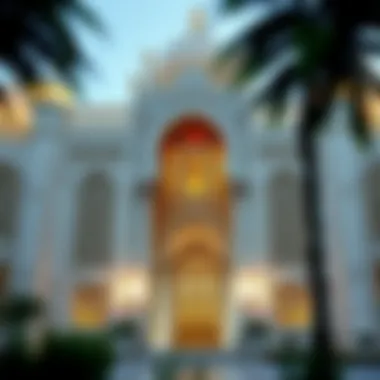
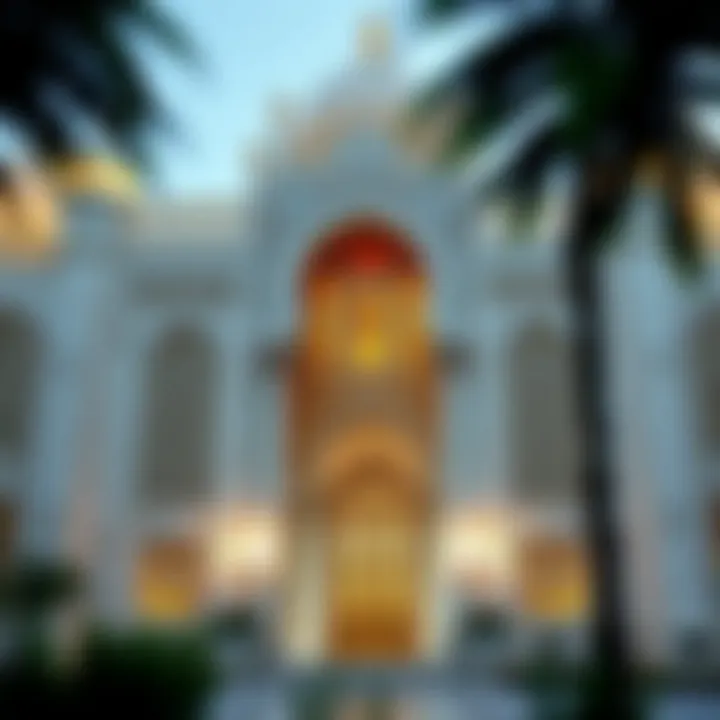
Intro
The White Palace stands as a testament to Dubai's evolving story, echoing tales of luxury and cultural richness within its walls. This architectural wonder catches the eye of many, drawing tourists and locals alike to explore its intricate designs and deep-seated historical significance. Known for its grandiosity, the palace embodies not just a striking aesthetic but also pivotal narratives tied to the emirate’s heritage and modernization. Its ambiance has an allure that goes beyond mere opulence, bridging the past with the present.
Local Culture and Community
The role of the White Palace in the context of Dubai’s local culture cannot be emphasized enough. It's not just a building; it serves as a vibrant hub that fosters community interactions and cultural celebrations. When we think about the local culture surrounding this magnificent edifice, a clear picture emerges of a lifestyle steeped in tradition yet open to influences from around the globe.
Cultural Festivals and Events
Various cultural festivals and events take place in proximity to the White Palace, enriching the communal atmosphere. These events showcase the diversity that Dubai is known for. Festivals such as the Dubai Shopping Festival and the Dubai Food Festival often utilize the palace as a backdrop for their activities, merging the artistic decor of the palace with the excitement brought by these events:
- Art Exhibitions: Local and international artists display their work, often fusing traditional elements with contemporary designs.
- Cultural Shows: Traditional performances highlight Emirati heritage, giving attendees a glimpse into the rich tapestry of the local culture.
Community Engagement and Activities
Community engagement around the White Palace goes beyond festivals. It has become a gathering spot for locals and expatriates, fostering connections through various activities. The area's layout encourages socialization:
- Workshops: Educational initiatives like pottery classes or traditional music lessons often find a home near the palace, inviting all ages.
- Walking Tours: These guided experiences promote healthier lifestyles, allowing the community to appreciate both the architecture and history while enjoying the vibrant surroundings.
Lifestyle and Amenities
The vicinity of the White Palace offers an array of lifestyle and amenity options, catering to both the extravagant and the everyday needs of visitors and residents alike. Its charm extends to the culinary landscapes and leisure activities, making it a favored locale for many.
Dining and Culinary Experiences
Culinary offerings near the White Palace speak volumes about Dubai's dedication to gastronomy. The mix of eateries ranges from traditional Emirati kitchens to upscale fusion restaurants:
- Local Delicacies: Discover exquisite Emirati dishes in restaurants, where flavors of saffron and cardamom create memorable dining experiences.
- International Cuisine: A plethora of choices that cater to various tastes, from Italian to Thai, makes this a culinary melting pot.
Recreational and Entertainment Options
For entertainment, the area around the White Palace hosts activities that suit everyone from families to solo adventurers:
- Parks and Green Spaces: Open areas where families can unwind, joggers can stretch their legs, and children can play are common attractions.
- Artistic Performances: The nearby theaters offer a range of shows that resonate with the cultural diversity present in Dubai.
The White Palace, connecting lifestyle with community engagement, stands as a symbol of what Dubai represents—luxury, culture, and the continuous evolution of a city that respects its past while embracing the future.
"The significance of the White Palace reaches beyond its sumptuous architecture—it is a vibrant part of Dubai’s heartbeat, where culture meets modernity."
In exploring the multifaceted aspects of the White Palace, it becomes evident how this landmark is integral not only to Dubai’s skyline but to the stories that intertwine within the community and cultural fabric of the city.
Preface to the White Palace
The White Palace in Dubai is not merely a building; it embodies the heart and soul of a rich culture intertwined with architectural magnificence. This landmark, often admired by residents and visitors alike, serves as a symbol of the Emirates’ rapid evolution while honoring its deep-rooted traditions. It’s important to delve into its history and significance, as the White Palace reflects the ambitions and cultural narratives that Dubai aims to project.
Overview and Historical Background
Constructed in the early 2000s, the White Palace was designed as a government residence, showcasing some of the most distinctive architectural styles from the Arabian Peninsula. Its aesthetics blend luxury with the traditional features of Emirati design—a true representation of the nation’s identity. The structure takes inspiration from the past while looking toward the future, presenting a harmonious balance that commands respect. In a city often seen as a hive of rapid development, this palace stands out as a venerated historic icon.
The original purpose of the palace was to serve as a residence for leaders and dignitaries, but over time it has evolved into a marker of Dubai’s aspirations on the world stage. From global business dealings to cultural exchanges, its walls have seen negotiations that have sculpted both local and international landscapes. Understanding the context of its establishment reveals how the White Palace moved from being a private estate to becoming a public emblem—a characteristic that defines the cultural narrative of Dubai today.
Architectural Significance
Architecturally, the White Palace is an exquisite blend of modernity and tradition. With its towering domes, intricate tile work, and elaborate carvings, it invites admiration from every angle. The layout is designed with attention to functionality and aesthetics, serving both ceremonial purposes and day-to-day activities.
The usage of white stone draws attention, reflecting light in a way that gives it a luminous quality during the day while evoking a majestic aura at night. This deliberate choice of material highlights not only lavish tastes but also signifies purity and peace, common themes in Arabian architecture. The juxtaposition of open spaces and intricate detail work captures a paradox: the grandeur of luxury against the backdrop of serene simplicity.
"The White Palace is more than just a building; it's a narrative of progress intertwined with an unwavering respect for tradition."
Visitors to the site can marvel at how traditional elements—such as arched doorways and columned porticoes—are harmoniously integrated with contemporary design principles. This architectural dialogue speaks volumes about Dubai’s ambition to preserve its heritage while embracing the future.
In summary, the White Palace is a foundational piece of Dubai's cultural and architectural tapestry. As we take a closer look at its design elements in the next section, we will unearth how these features contribute to the overall narrative of a city that is constantly redefining itself.
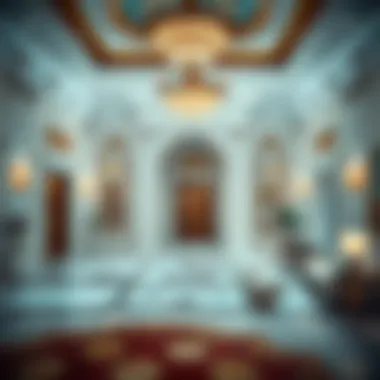
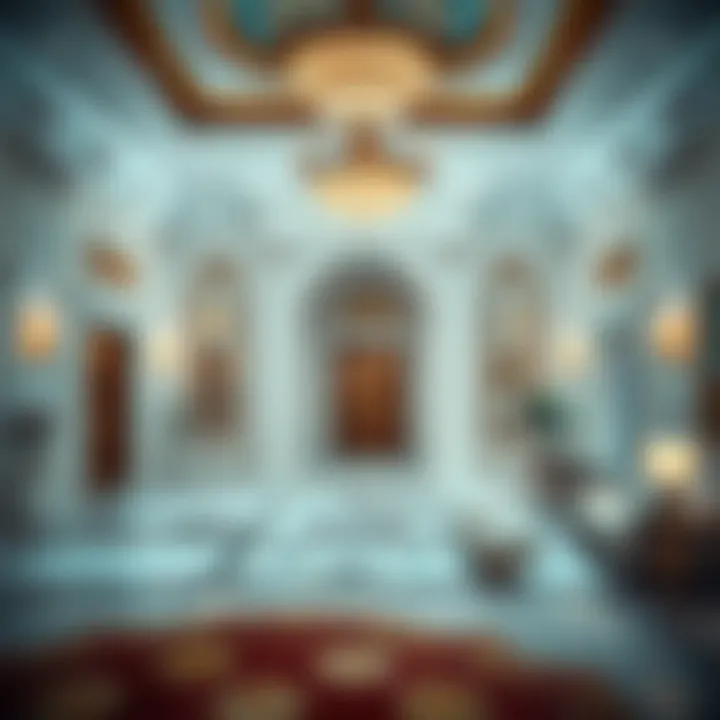
Design Elements of the White Palace
The design elements of the White Palace are vital to understanding its essence within Dubai's architectural narrative. This section dissects the intricate details of materials, textures, color palettes, and landscaping that not only define the building but also reflect the cultural heart of the emirate. The pride taken in these elements illustrates a commitment to craftsmanship and aesthetic excellence, affirming the White Palace’s status as a significant cultural landmark.
Material and Texture
The materials used in constructing the White Palace speak volumes about both luxury and heritage. The smooth facade, crafted primarily from locally sourced limestone, exhibits a dry climate's adaptability while exuding cool elegance. This choice of stone serves a dual purpose; it helps in temperature moderation in Dubai's sweltering heat and also establishes a link with traditional Emirati architecture, where local materials are valued.
Textures play a critical role in the visual appeal of the palace. From the polished stone surfaces to the intricate carvings that embellish door frames and window sills, the tactile intricacies invite both admiration and inquiry. These carvings often depict motifs significant to Emirati culture, fostering a connection between the artistic expressions of the past and a modern audience. Their surfaces catch and reflect light differently throughout the day, creating a dance of shadows that keeps the viewer's experience dynamic.
Color Scheme and Aesthetics
The White Palace's color scheme is striking yet tasteful, reflecting the sun-drenched landscapes and sandy hues of Dubai. Predominantly white, the structure stands out against the azure sky, symbolizing purity and peace. Accents of gold in the detailing serve a dual purpose, instilling a sense of opulence while echoing the golden sands of the surrounding desert.
This aesthetic choice is more than just a visual delight; it represents a harmony with nature. The reflective quality of the white exterior not only glorifies the sunlight but also symbolizes a new era in architectural design, one that prioritizes sustainability and environmental synergy. The careful blending of aesthetics with the local landscape creates an inviting atmosphere, making the palace an enduring landmark amid the city’s evolving skyline.
Landscaping and Outdoor Spaces
Landscaping around the White Palace is not just about greenery; it encapsulates the cultural narrative of Dubai. The gardens are meticulously designed to mirror the traditional Arabic landscape. Lush palms and native plants are carefully integrated, providing shade and beauty while minimizing water usage. This strategic incorporation of native flora supports local biodiversity, a growing consideration in urban planning, displaying a sensitivity to environmental concerns.
The outdoor spaces are crafted for both leisure and contemplation. Wide pathways flanked by fragrant gardens invite visitors to wander and reflect. There are even fountains that echo the sound of flowing water, a considered element nodding to the historical importance of water in Emirati life, especially in the desert context. Such features enhance the experience of the palace, making it both a visual feast and a serene retreat.
"In architecture, the details are not just details; they make the design." – Charles Eames
By analyzing these elements, it becomes evident that the White Palace is a synthesis of tradition and modernity, each contributing to its architectural integrity and cultural significance within Dubai's urban landscape.
Cultural Relevance
The cultural significance of the White Palace in Dubai stretches far beyond mere aesthetics. It serves as a cornerstone of Emirati identity, standing tall amid the modernization that has engulfed large swathes of the city. This palace is not just an architectural feat; it encapsulates the very essence of what it means to be Emirati today. As such, understanding its importance is vital for anyone looking to grasp the evolving identity of Dubai.
The Symbol of Emirati Identity
The White Palace stands as a symbol of pride and unity for Emiratis. Its striking architecture and grandiosity reflect a rich cultural heritage that has seamlessly blended traditions with modernity. For locals, it functions as a sentinel of their history, reminding them of their roots even as the city evolves rapidly. Many residents recall attending cultural events at the palace, which facilitates community bonding. In a place where rapid changes can create a sense of disconnection, the palace helps preserve the shared values and stories of the Emirati people.
Visitors often remark on the sense of honor and dignity that radiates from the palace. It is a marker of national identity that invites tourists to comprehend the unique narrative of the UAE, enriched by its vibrant history and traditional customs. Through various ceremonies and state functions held within its premises, the palace solidifies its status as not just a building, but a living, breathing monument to Emirati culture.
"To understand a culture, one must first experience its symbols; the White Palace invites everyone to explore the heart of Emirati society."
Integration into Local Traditions
The White Palace is not merely a geographical landmark; it's interwoven into the fabric of local traditions. Festivals, weddings, and community gatherings take place within its lavish gates, making it a hub for cultural expression. This integration showcases the palace as more than just a royal residence; it plays a pivotal role in everyday life.
For example, during significant observances like Eid al-Fitr, the palace transforms into a site of communal festivities. Local families gather, drawing together generations to share meals and cultural narratives that center around their shared experiences. These practices reinforce familial bonds and strengthen ties within the community, highlighting the importance of the palace.
Furthermore, the artistic elements of the White Palace serve to honor local craftsmanship. The patterns and motifs found throughout its design reflect traditional Emirati artistry, thus fostering a sense of pride among creators and admirers alike. This connection demonstrates how the palace acts as a custodian of cultural practices, promoting awareness and appreciation for laborious artisanal skills often passed down through generations.
Lastly, the integration of modern utilities alongside traditional values is exemplified through various educational and cultural programs hosted at the White Palace. Whether through art exhibitions or historical lectures, it continually engages the public, ensuring that the traditions maintain relevancy in contemporary society.
In essence, the White Palace is both a physical and symbolic structure that captures the complexities of Emirati culture—a monument that ties past to present.
Role in Dubai's Urban Landscape
The White Palace, a gem in the heart of Dubai, stands as a testament to the city’s rapid transformation and growth. Understanding its role in the urban landscape is crucial for grasping how this iconic structure influences both the built environment and cultural narratives within the metropolis. The palace encapsulates not only the elegant architectural style but also presents historical significance and modern relevance as a cornerstone of community identity.
Influence on Neighborhood Development
The surrounding neighborhoods of the White Palace have witnessed considerable development, largely due to its presence. This majestic structure acts as a magnet, drawing in tourists, expatriates, and residents alike. You'll find it right at the intersection of tradition and modernity. The surge in nearby cafes, hotels, and boutique shops reflects how the palace has catalyzed growth and investment in the area.
One cannot overlook how it shapes real estate values. Properties in close proximity to the White Palace tend to command higher prices, demonstrating the undeniable impact of this landmark on the local economy. For city planners and developers, the area shows how blending luxury with cultural heritage boosts attractiveness for both residents and investors.
Furthermore, the White Palace has sparked new infrastructure projects. Roads and public transport routes have been revised to better serve visitors and locals, enhancing accessibility. Simply put, the palace is not just a building; it inspires the very framework of community life around it.
Gentrification and Cultural Heritage
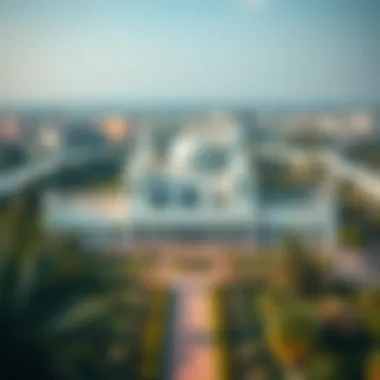
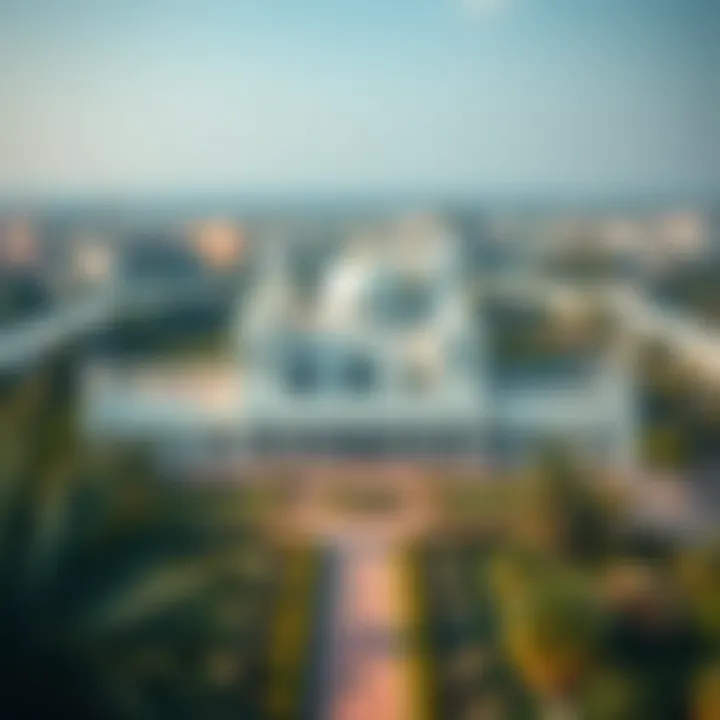
Gentrification is often a double-edged sword, bringing both positive change and challenges. With the infusion of capital-driven development around the White Palace, the balance between modernization and cultural preservation becomes critical. As affluent developments emerge, long-standing neighborhoods are at risk of losing their character and charm, causing tension among residents. You can feel the tug-of-war in the air between new high-rises and traditional homes.
However, the White Palace plays a pivotal role in these discussions. It serves as a constant reminder of the city's rich history and identity, grounding newer developments in local culture. Many initiatives aimed at preserving the cultural essence of the area are more effective when linked to this iconic structure. Artists and cultural organizations often gather here, hosting events that celebrate Emirati traditions and arts, which counterbalance the forces of gentrification.
Ultimately, the White Palace emerges as a beacon that fosters dialogue about where the city is headed while honoring its past. Its commitment to being a cultural hub illustrates how urban growth can harmonize with the preservation of heritage, creating a fertile ground for community interaction and collective memory.
In exploring the interplay between development and tradition, one can see that the White Palace isn't just an architectural marvel; it is a vital player in the ongoing story of Dubai. As time moves forward, its influence will likely continue to shape the city’s evolving identity and encourage thoughtful consideration of how urban spaces can reflect both innovation and history.
Visiting the White Palace
When planning a trip to Dubai, few destinations spark more intrigue than the White Palace. It's not just a building; it’s a gateway into the cultural tapestry that makes up this vibrant city. As visitors step foot on its grounds, they are stepping into a narrative filled with stories of heritage and luxury. The importance of visiting the White Palace lies in its multidimensional allure, offering tourists, residents, and expatriates a unique lens through which to explore Emirati culture.
Tourist Information and Access
Accessing the White Palace is quite straightforward, yet the experience you gain is anything but simple. Located strategically in Dubai, this architectural gem stands proud, a landmark that catches the eye of anyone journeying through the city. Its grandeur often draws visitors in like moths to a flame, but knowing some details beforehand will smooth the path.
- Opening Hours: Generally, the White Palace welcomes guests throughout the week. However, it's advisable to check specific hours, especially during holidays, as they may vary.
- Entry Fees: There are no hefty tickets to access the grounds. Instead, visitors can stroll through the beautifully landscaped area free of charge.
- Transportation Options: The palace is conveniently accessible via public transport and taxi services, making it easy for anyone to reach.
Visitors should also look into guided tours, which offer deeper insights into the palace’s history and its significance in Dubai. These tours often add a personal touch, reflecting the stories and traditions of the Emirati people. Such experiences not only enrich one's understanding but also cultivate a sense of respect for local customs and heritage.
Local Amenities and Attractions Nearby
Situated in a prime location, the White Palace is surrounded by a plethora of amenities and attractions that enhance the visitor experience. This proximity to other landmarks allows guests to maximize their time and delve into various aspects of Dubai’s luxurious lifestyle.
Here are a few noteworthy spots nearby:
- Green Spaces: The palace is enveloped by well-maintained parks that provide perfect settings for picnics or leisurely strolls. Al Wasl Park is particularly popular among families.
- Shopping: For those wishing to indulge in some retail therapy, City Walk is just moments away, offering a unique blend of shopping, dining, and entertainment experiences.
- Cultural Sites: The Dubai Opera, not too far off, showcases world-class performances and events, perfect for visitors looking to dive deeper into the local arts scene.
- Dining Options: A quick walk or a short taxi ride can lead you to a selection of eateries, where both traditional Emirati cuisine and international fare are available.
In essence, visiting the White Palace is more than merely viewing a building; it’s about immersing oneself in a narrative that unfurls through its gardens, surrounding neighborhoods, and the stories of the people who make Dubai a kingdom of dreams.
"The White Palace is not just a place but a manifestation of the cultural heart of Dubai that beats through its architecture and the stories it tells."
By taking the time to appreciate this landmark, tourists position themselves to navigate the rich culture of Dubai, understanding the harmony between tradition and modernity that defines this enchanting city.
Personal Experiences: Tales from Visitors
Understanding the White Palace isn’t just about admiring its architectural brilliance; it also involves delving into the memories and impressions it leaves on those who visit. Personal experiences provide a unique lens through which we can gauge the palace’s impact on its surroundings. Stories shared by visitors reveal a tapestry of emotions, cultural connections, and personal revelations, highlighting why the White Palace is more than just a stunning building—it’s a symbol of experience and memory for many.
Incorporating these perspectives allows potential tourists, residents, and marketers to grasp the multifaceted nature of this landmark. It’s one thing to see photographs of the White Palace; it’s quite another to hear firsthand accounts of awe inspired by its grandeur or the sense of pride expressed by Emirates when they share their stories about it.
Interviews and Perspectives
Personal narratives often come to life through interviews, where visitors recount their journeys to the palace. These stories showcase varied lifestyles and cultural backgrounds, enriching our understanding of the White Palace's role within Dubai's fabric.
For example, a local resident may share anecdotes about childhood visits, highlighting family traditions tied to the site. They might recount special occasions celebrated there, illustrating how the palace serves as a backdrop for personal history. Meanwhile, expatriates may convey what the palace represents in terms of belonging and cultural integration. Their perspectives reflect on how they experience Emirati culture through the lens of such significant landmarks.
Stories often touch upon how architecture can evoke emotions, with some expressing how the palace's intricate details and serene surroundings inspire reflection or hope. Others might emphasize the artistic contributions of local artisans, which transforms an experience into a discovery of culture, community, and creativity.
Cultural Events and Activities
The White Palace is a vibrant hub for various cultural events and activities, drawing visitors from all walks of life. Community gatherings, art exhibitions, and festivals weave additional layers into the narrative of the palace, illustrating its significance beyond architecture. These events often blend traditional practices with modern artistic expressions, offering an environment for sharing cultural values and heritage.
Attending these events allows visitors to engage directly with Emirati traditions. For instance, during national celebrations, the palace becomes a canvas for artistic displays, showcasing the nation’s artistic evolution. Traditional dance performances might take center stage, inviting guests to participate in the celebration. This participation fosters a sense of belonging, as people from diverse backgrounds commune in admiration of the Emirati spirit.
Moreover, cultural events often include workshops where participants can learn about traditional crafts or culinary arts, deepening their connection to the local culture. These opportunities create shared experiences, enriching individual perspectives and leaving lasting impressions on visitors.
In summary, the White Palace is a place where personal stories and cultural events converge, creating a unique fabric of experiences. The insights drawn from visitor narratives not only enhance our understanding of the palace but also contribute to the ongoing conversation about its role in enriching Dubai's cultural identity.
Comparative Analysis
The comparative analysis in this article serves as a crucial lens through which the architectural and cultural essence of the White Palace can be understood in relation to other noteworthy landmarks and architectural styles not only in Dubai but across the wider region. By examining the similarities and differences among these structures, we can appreciate how the White Palace stands out in terms of design, function, and cultural significance. This analysis aids in contextualizing the White Palace's architectural choices within a broader narrative of urban development and heritage preservation.
In this exploration, we highlight specific elements that present both benefits and considerations pertinent to comparative analysis. Understanding these facets can illuminate how different architectural designs serve distinct cultural purposes, reflecting the evolution of societies within Dubai and beyond. Moreover, it equips residents, expatriates, and tourists with a nuanced appreciation of their surroundings, fostering a richer interaction with these landmarks.
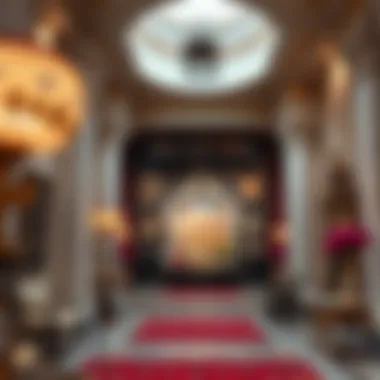
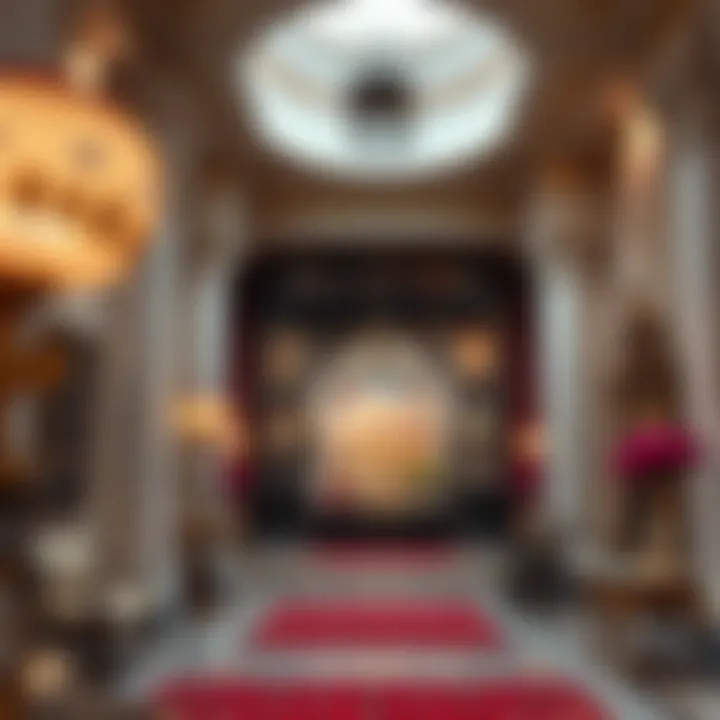
Similar Landmarks in Dubai
Dubai is a city teeming with architectural marvels that reflect its rapid urbanization and cultural diversity. Beyond the White Palace, there are several landmarks that merit comparison.
- Burj Khalifa
- Dubai Marina
- Sheikh Zayed Road
- As the tallest building globally, the Burj Khalifa embodies modern engineering excellence. It represents the ambition of Dubai to be at the forefront of skyscraper design. While the White Palace showcases traditional aesthetics, the Burj Khalifa's sleek lines and glass facade signify contemporary innovation.
- The Marina area features a blend of luxury residential and commercial buildings. It offers a different take on integrated living spaces, contrasting with the more standalone elegance of the White Palace, with its distinct cultural backdrop.
- Lined with high-rises and office spaces, this road is crucial to Dubai's economic identity. Unlike the White Palace, which is imbued with historical significance, the architecture along Sheikh Zayed Road emphasizes commercial prowess.
Architectural Styles Across the Region
The architectural landscape of the Middle East is as diverse as its cultures, from the historic forts of Oman to the elaborate palaces found throughout Qatar. The White Palace incorporates elements that resonate with both traditional Islamic architecture and modern design.
- Traditional Islamic Architecture
- Modernist Influences
- Cultural Fusion
- Characterized by intricate patterns, elaborate calligraphy, and lavish decorations, this style is evident in many regional landmarks, yet the White Palace manages to strike a balance by infusing these traits with contemporary luxury.
- There is also a growing influence of modernist architecture seen in various structures across the Gulf states. Aspects like minimalism and functionalism are increasingly occupying spaces where culture and identity are expressed through architectural form.
- The blending of various cultural influences is evident in many recent projects, echoing the historical trading routes that once brought diverse traditions to the region. The White Palace stands as a testimony of this fusion, connecting the past with the present.
This comparative analysis doesn't merely seek to highlight differences; it aims to provide a deeper understanding of how each landmark contributes to the vibrant tapestry of Dubai's architectural landscape. As we analyze these comparisons, the essence of the White Palace and its continued relevance to the city's identity come into sharper focus.
Sustainability and Preservation Efforts
The White Palace stands as a monument of both architectural beauty and cultural identity in Dubai. Its preservation and sustainable practices are crucial not only for maintaining its structure but also for ensuring that the surrounding environment continues to thrive. As the city moves toward modernization, the challenges related to sustainability become more pressing, making it essential to look at how historical landmarks like the White Palace can adapt without losing their essence.
Green Technologies and Practices
In today’s world, integrating green technologies into architectural preservation is key. The use of renewable energy sources such as solar panels and wind turbines can dramatically reduce the carbon footprint of the White Palace.
- Solar Energy: Solar panels can easily be incorporated into the roof design, providing energy for lighting and heating without altering the aesthetic appeal.
- Water Conservation: Rainwater harvesting systems can be employed to collect and reuse water for landscaping, reducing the reliance on municipal water supply.
- Sustainable Materials: When repairs or restorations are needed, using locally sourced and sustainable materials ensures that the impact on the environment is minimal.
These innovations allow the White Palace to embrace a modern approach while telling its historical narrative.
Preserving Cultural Heritage
Preservation of cultural heritage extends beyond the physical fabric of a building; it encompasses the stories, traditions, and local customs that the White Palace embodies. Careful consideration is necessary to maintain these aspects while promoting tourism and development.
- Community Engagement: involving local communities in preservation efforts fosters a sense of ownership and encourages more sustainable practices. Programs that educate residents about the palace's history can revitalize interest and appreciation for local heritage.
- Cultural Events: Hosting events that celebrate Emirati culture within the palace grounds could serve dual purposes: generating funds for upkeep while also preserving traditions.
- Careful Restoration: Restoration should be done with a mindset not just to repair but to tell a story. Each architectural feature has significance—thus, ensuring that any restoration work does not compromise the historical narrative is vital.
Thus, balancing modernization with tradition requires a concerted effort from all stakeholders, ensuring that the White Palace continues to be a beacon of cultural pride while utilizing sustainable practices for the greater community.
In essence, the sustainability and preservation efforts for the White Palace are not just about maintaining a building but nurturing the essence of a vibrant culture and ensuring that it remains relevant for future generations.
Epilogue: The Legacy of the White Palace
The White Palace stands as a beacon of cultural and architectural heritage in Dubai, embodying a rich dialogue between tradition and modernity. As this article unravels the layers of its significance, it becomes clear that the palace is more than just an exquisite building; it serves as a cornerstone of Emirati identity and a symbol of the nation’s aspirations. Its very existence is a testament to the unity of aesthetic appeal and historical narrative, seamlessly blending the past with the vibrancy of contemporary Dubai.
Impact on Future Generations
Looking ahead, the legacy of the White Palace is poised to resonate through generations. It provides a tangible connection to the region’s history, inspiring young Emiratis and visitors alike to appreciate and engage with their cultural heritage. Educational initiatives around the palace could become more integrated into school curricula, ensuring that children not only learn about but also experience the historical narratives that shaped their community.
- Cultural Education: Schools could organize field trips, encouraging students to explore local history firsthand.
- Workshops and Programs: Fun, community-based programs that involve art and architecture can spark interest among youth to explore careers in these fields.
By establishing such connections, the palace supports the notion that history isn’t just behind closed doors; it lives on, breathing alongside the new. Moreover, as Dubai continues to expand and evolve, the White Palace serves as a physical reminder of the importance of balancing growth with preservation.
Reflections on Cultural Significance
The cultural significance of the White Palace cannot be overstated; it encapsulates the essence of the Emirati ethos. The architectural elements reflect a blend of traditional motifs and modern design, a narrative that speaks volumes about the UAE's journey from a humble fishing village to a global hub of luxury. This duality within its structure serves as a conversation starter about cultural identity, a matter of utmost importance in a rapidly globalizing world.
- A Cultural Hub: The palace hosts various cultural events that allow the community to come together, fostering a shared sense of belonging.
- Observing Traditions: By hosting art exhibits, music festivals, and culinary showcases, it revives traditional practices and celebrates contemporary expression.
Ultimately, the White Palace epitomizes the fusion of history and progress. It stands not merely as a site of aesthetic enjoyment but as a cultural lighthouse, guiding both residents and tourists in understanding Dubai's rich narrative. The careful attention to preserving its heritage ensures that future generations will have much to learn from this magnificent structure, instilling pride and passion for their roots.
"Heritage is not what we inherit from our ancestors, but what we leave for our descendants."



